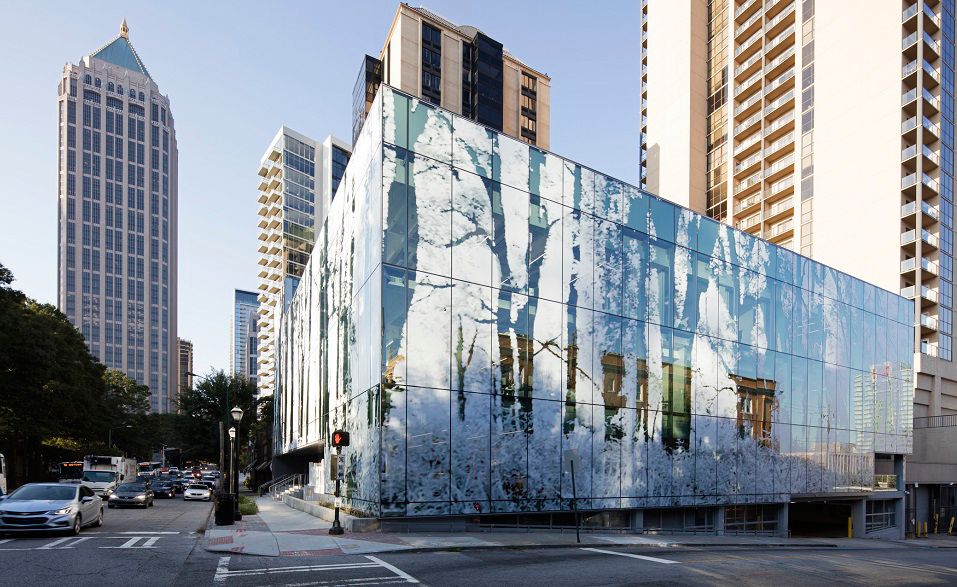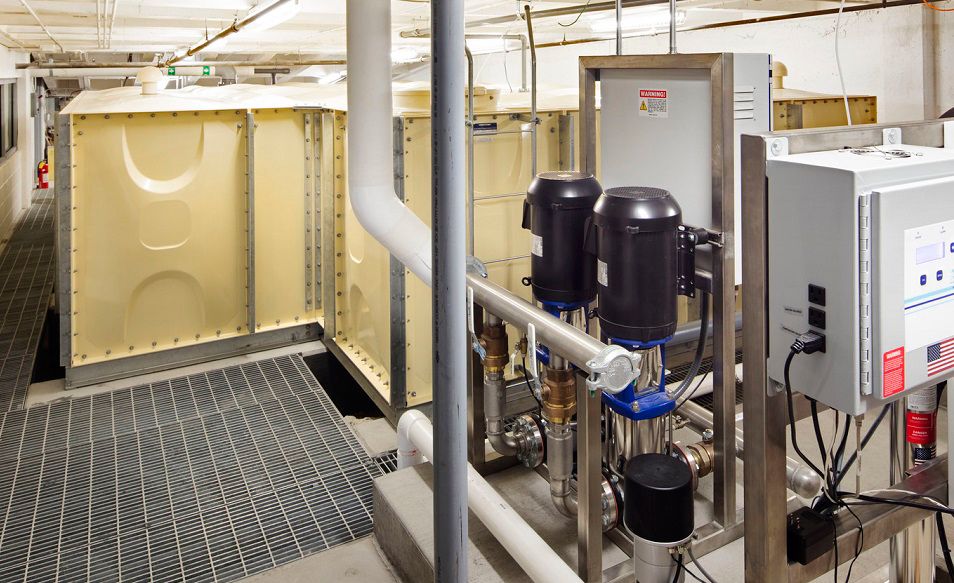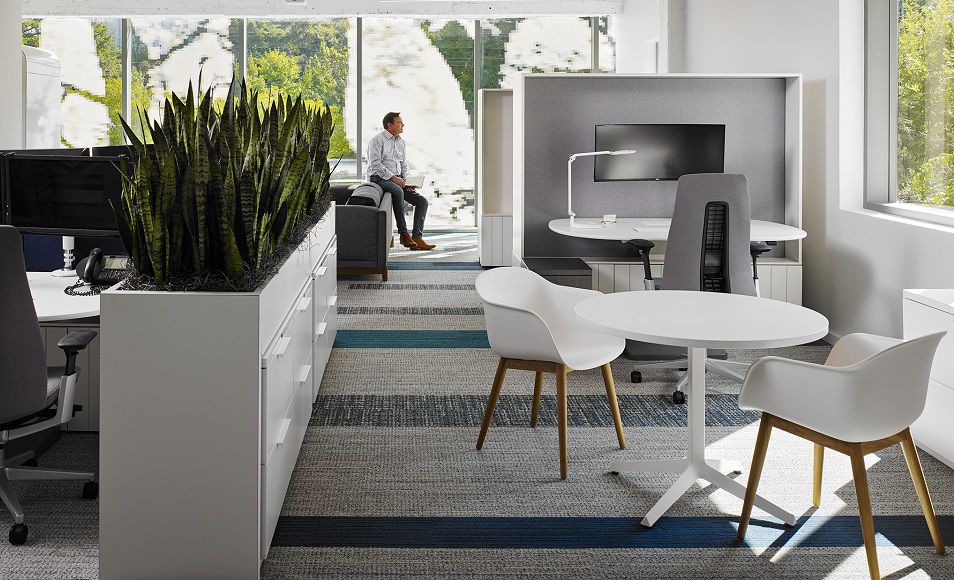As we worked to create our new headquarters, we took into account what was not only best for our customers, designers and employees, but also our planet. Saving the best for last, we’re closing our blog series on the design and construction of Interface’s new global headquarters by outlining how we kept sustainability top of mind in every decision made about the building.
Forest in the city
Located in the heart of Midtown, Atlanta, Interface’s new headquarters pays homage to the city’s goal of restoring its tree canopy to 50 percent by encasing the building in a unique forest overlaid façade. The building wrap is a bold statement that references the company’s Factory as a Forest methodology, which looks to the local ecosystem for inspiration on achieving sustainability and productivity.
The recyclable polyester sheath that wraps the north and east faces of the building features a white transparent forest landscape. The end result allows natural light into the workplace and simultaneously conserves energy by reducing heat from sunlight.
Reduce, reuse, recycle
Interface strategically decided to make the headquarters an adaptive reuse project by renovating an existing 1950s-era multi-tenant office building. Although new buildings can be built extremely “green” and energy-efficient, it can still take anywhere from 10 to 80 years to make up the negative impacts of a new construction project due to the role of embodied carbon within building materials.
During the course of our 11 months of renovation, we:
- Diverted 93 percent of waste from landfill, including 102,160 pounds of concrete and 45,420 pounds of steel
- Donated 50 items to the Life Cycle Building Center, an Atlanta non-profit
After renovation and through our work toward LEED certification, Base Camp’s performance metrics confirmed our commitment to water and energy with:
- 78 percent of water use reduction through rainwater collection
- 50 percent energy use reduction compared to code-compliant buildings
On a smaller but just as important note, the building hosts recycling and composting stations to ensure our employees also consider how their daily habits contribute to our greater sustainability mission.
Innovative systems at work
In addition to tackling carbon in the building’s construction, the Base Camp project addressed ongoing water usage. The building boasts a 15,000-gallon underground cistern which offsets 100,000 gallons of water each year. Rainwater harvested through the building’s slatted roofing is treated, then used to flush fixtures and to irrigate greenery such as the rooftop succulent garden.
We also use a unique, energy-saving HVAC chilled-beam system. While not yet widely adopted in the US, the chilled beams provide a multitude of benefits, including better tenant comfort at a higher temperature through humidity control. Plus, it requires less installation space, allowing for higher ceilings and more storage space on each floor.
“While working with Interface, we went to great lengths to ensure its new headquarters would reflect its corporate identity as a leader in sustainability,” said Stanton Stafford, Managing Principal of Integral Consulting Engineering, the Atlanta Studio of Integral Group. “The Interface team expected more than just an economic justification with the products we selected. After analyzing projected energy and water consumption, we selected systems that would provide positive benefits toward the company’s goals such as water harvesting and a chilled-beam system.”
Green commute
Part of creating an environmentally conscious workplace was offering employees and guests alternate transit options. We relocated directly across from public transit (MARTA) and provide all the necessities for easy biking, including storage and showers. Employees and visitors use public transit more than ever due to its close proximity to the global headquarters.
Benefiting people & planet
Our mission is to create positive spaces, whether in our own buildings or those of our clients. The design of Base Camp was no different. Our new headquarters is on target to achieve both LEED platinum certification and WELL standards, ambitiously combining sustainability and employee well-being in one cohesive building.
LEED, the most widely used green building rating system in the world, verifies resource-efficient, high-performing, healthy and cost-effective buildings; benefiting people, the planet and a business’s profits. WELL standards account for a holistic approach to health and wellness, while optimizing design, operations and work behaviors to advance human health.
Although we encountered challenges and conflicting requirements along the way, we satisfied LEED and WELL needs through deliberate choices made during the renovation of the building. For example, while being in close proximity to public transportation supports LEED requirements, the accompanying noise contradicts basic WELL standards. To combat this, we sourced thicker exterior glass to create a more desirable acoustic environment.
Through our partnerships with JLL, Perkins+Will, MSTSD and Parkside Partners, we created a functional space that benefits employees, customers and the community while meeting sustainability and wellness goals.
Back to the Basics
In 2015, Interface began conceptualizing what it would look like for us to fully embrace our sustainability goals in more ways than manufacturing and products. Base Camp is a living example of our dedication to sustainability for our employees, guests, partners and global and local community. It highlights our obligation to run Interface in a way that is restorative to the planet and creates a climate fit for life.
Although this signifies the end of our Designed For… blog series, the conversation is not over. We will continue to further strengthen our sustainability efforts, providing opportunities for the industry as a whole to create change and make a positive impact on the environment


